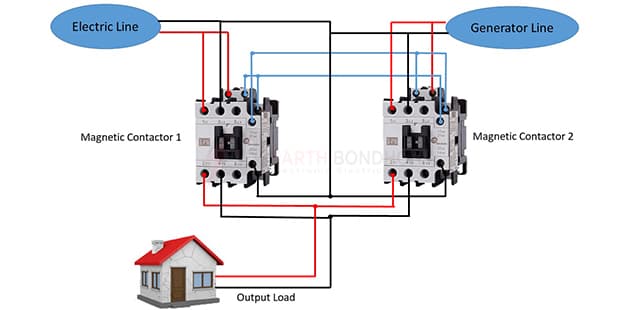Automatic changeover Switch using Contactors:
This diagram shows how to make an automatic changeover switch using contactors. In this circuit diagram, we use a simple 2 magnetic contactors, a power generator, and a single-phase energy meter. This circuit is very easy to make. If you want to make a good connection like our diagram you can check our youtube video at the below link. Make sure you have a good idea about electrical wiring and electricity, then follow our diagram and make a good circuit and use it.
Advertisements
Components needed For this Project:
You can get the components from any of the sites below:
- Magnetic Contactor 40A [See Buy Click Amazon]
- Single Phase Generator 2000W[See Buy Click Amazon]
- Single Phase Energy Meter [See Buy Click Amazon]
*Please note: These are affiliate links. I may make a commission if you buy the components through these links. I would appreciate your support in this way!
Advertisements
Components used to make the Automatic changeover Switch using Contactors:
A magnetic contactor is an electromagnetic switching device. It is generally used for controlling 3-phase Motors. The operation of a magnetic contactor is similar to that of a Relay. but a relay is used for low-power or low-voltage connections, and a magnetic contactor is used for high-power or high-voltage connections. As soon as the supply is applied to the magnetic contactor coil. its normally open contacts are closed and normally closed contacts are opened and the associated devices are also operated. This is how a magnetic contactor works.
02. Power Generator:
An electric generator is a type of Electrical device that converts mechanical energy or power into electrical energy or power. However, dynamo generally refers to generators only. The first generator built was called a dynamo. This electrical device makes this conversion using the principle of kinetic electromagnetic energy generation. According to Farad is principle of electromagnetic induction, a dynamic electromagnetic induction is induced in a conductor when it passes through a magnetic flux.
A Single-Phase Energy Meter is a sort of Watt-Hour meter. It consists of two Electromagnets. Single-Phase Energy Meter is also Popularly known as a watt-hour meter. 1 Magnet is called the shunt magnet Ml which is Mounted with a Pressure coil. The Pressure coil is a long coil Made of fine Copper wire that is connected across the Supply single-phase line. Single-phase energy meters are suitable for measuring single-phase AC current flow frequencies of 50/60 Hz, which are used for fixed indoor installation systems.
Thank You for visiting the website. Keep visiting for more Updates.
Frequently asked questions
The automatic power supply change-over switch is a device that links the load and mains power supply or the alternative power supply together. This enables the use of either the mains power supply or an alternative source when there is an outage on the mains source. This can either come in with 3 phases or a single phase.
A three-phase transfer switch (ATS) forms the interface between the Gen set utility and the consuming electrical equipment. the main function of ATS is, it monitor power sources for failure & transfer load from 1 power source to another.
The advantages of using a contactor to switch the power supply are: (1) It does not generate heat as the SSR does. So there is no need for a heat circuit diagram sink to dissipate the heat. (2) It normally comes with 2 poles or 3 poles. So when it is off, both power supply lines are open.
1600AMP 4-POLE Automatic Changeover Switch. This unit is an integrated type with self-input and self-recovery power supply functions. It has a rapid response time of 1.2 seconds. The maximum voltage is 220 or 380 volts.
Suburban's Automatic Changeover Regulator automatically switches from an empty service cylinder to a full reserve cylinder, ensuring continuous gas flow to appliances. A highly visible full/empty indicator signals a refill.
Read more Single Phase Wiring
What is a kilowatt-hour (kWh) | kwh formula | What does kwh mean
Introduction to Electrical Units and CircuitskW and kWh on your electricity bill As your home uses electricity during...
What is the Difference Between kVA | What does KVA mean | kVA formula
Difference Between KVA ExplainedWhat does KVA Mean? There are technical terms aplenty when it comes to generators, and...
Power Factor | Power Unit | Energy | Electricity Unit
Power factor definition | Calculating Power FactorPower Factor Values In a purely resistive circuit, the power factor...




0 Comments
Trackbacks/Pingbacks